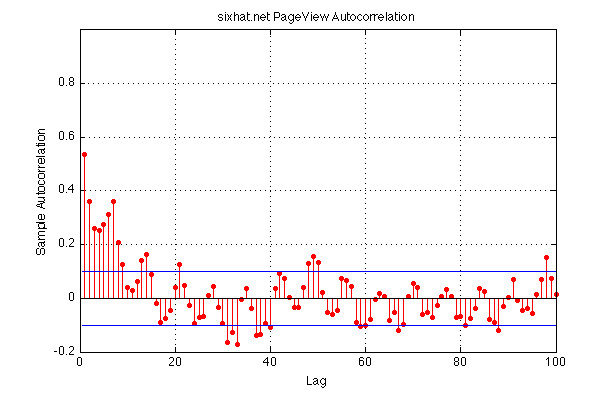
How can a Slashdot, or digg, front page affect your blog pageviews over time? I’m not talking about those huge amounts of traffic that pounce servers when you are being hit at 500 requests per second, but… what happens after? Is that reflected also in the days following the event? And what about non-famous blog posts? Do they affect pageviews in the days following publication? Is there a correlation?
Today I took the pageviews data of this blog for the past year. It is a timeseries so I calculated its autocorrelation. Autocorrelation measures the cross-relation between a signal and itself, showing hidden time patterns. Autocorrelation lays between -1.0 and 1.0, -1.0 meaning full anti-correlation, 1.0 full correlation, and 0.0 no type of correlation at all.
You can see in the above figure that the daily pageviews of sixhat.net are positively correlated during the first days after a blog article is published. After 2 days, that blog article doesn’t really influence the pageviews anymore. Another observation is that you have this weekly pattern observed in the correlation given by the 7th bar.
So, how can this help your blog posting strategy?
The first conclusion from this graph is that you shouldn’t really let time pass since last posting. Blogging is a regular thing and after 1 or 2 days you lost all the influence your last post had on you pageviews. After one week without posting all your pageviews are due to organic search and are not influenced by your latest and greatest rambling about Autocorrelation.
The second point to make is that this only applies to this blog in particular. You should analyse your own blog. Download the data from your Google Analytics account and use Matlab or R (free) to compute the autocorrelation. In matlab use the function autocorr(), in R use the function acf().
Besides pageviews you might want to test for other variables: click through rate, returning users, bouncing rate, etc… You might get insightful information about the performance of your blog that might help you decide your publishing strategy.